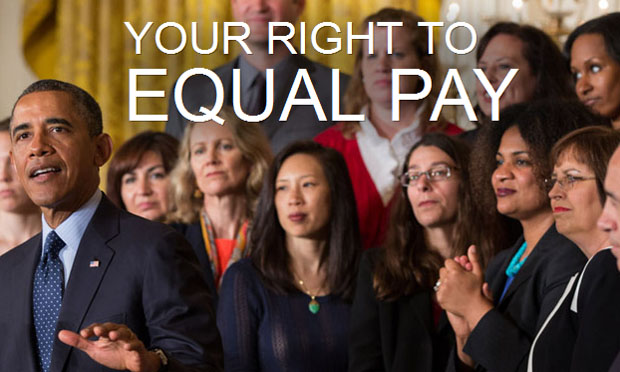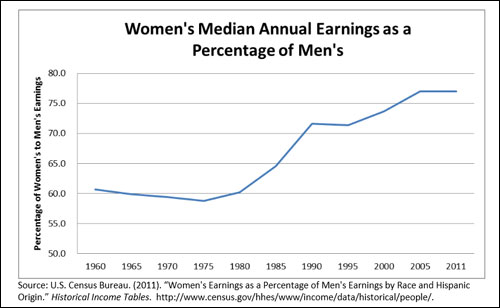Despite progress in the fight for gender equality in the workplace, women continue to face a broad range of difficulties. While they’ve made strides in breaking through the “glass ceiling,” they often face other challenges, including discrimination and sexism. A substantial gender pay gap persists around the world. In America, it is present from Wall Street to Silicon Valley to Hollywood. Even in the medical profession, there are substantial pay gaps.
The U.S. National Equal Pay Task Force issued a report in 2013 — 50 years after the 1963 Equal Pay Act, signed by President Kennedy as part of the “New Frontier” programs — and noted the following:
Over the last 50 years, the wage gap between women and men has closed by 17 percentage points. Women earned on average 59.8% of men’s pay in 1963, and today, the wage ratio is 77%. The narrowing of the wage gap reflects in part larger economic changes affecting men and families. For instance, a change in the wage gap results not only from a raise in women’s real earnings (those adjusted for inflation), but also from a drop in real earnings for men since the mid-1970s. Women’s real earnings have increased by about 71% from $21,646 in 1960 to $37,118 in 2011, while men’s earnings have increased at a significantly lower rate, 35%, from $35,675 in 1960 to $48,202 in 2011.
To better understand the causes and remedies for this gap, scholars have examined the role of workplace competition and its effect on female employment, as well as how long days and “overwork” could affect wages. Yet the precise causes of the gap are complicated, and it can be difficult to keep up with the nuanced research history (see the Gender Action Portal, from the Women and Public Policy Program at Harvard Kennedy School), even as progress slowly moves forward. In 2009, President Obama signed the Lilly Ledbetter Fair Pay Restoration Act, which removed the statute of limitations for persons filing pay discrimination claims with the U.S. Equal Employment Opportunity Commission (EEOC).
In a 2014 article in the Cambridge Journal of Economics, “The 40-year Pursuit of Equal Pay: A Case of Constantly Moving Goalposts,” authors Jill Rubery and Damian Grimshaw of the University of Manchester examine scholarly literature relating to Europe and the United States within four analytical perspectives: economic, sociological, institutional and organizational. Their thesis is that when there has been identifiable progress toward improved equality, the “goalposts” have moved, and thus gender pay equality proves to be an elusive target.
The paper usefully reviews and defines the long research history, noting highlights and turns:
- In earlier research literature — which subsequently became controversial — scholars such as Solomon W. Polachek of the University of North Carolina and Gary S. Becker of the University of Chicago argued that the pay gap is caused by decisions by women to focus on domestic activities rather than education and the development of their own human capital. Scholars have noted that the effect of the education differential worsens when women take long breaks from the workforce to have children.
- Such economic-based arguments suggested that the gender pay gap was derived primarily from women’s behaviors and preferences, and ignored any potential institutional or discriminatory barriers. Some researchers have criticized these assertions: Paula England of New York University explains that women entering predominantly female occupations do not incur lower wage penalties when they take breaks from the labor market. In other words, the “data do not show that women are penalized less for time spent out of the labor force if they choose predominantly female occupations than if they choose occupations more typical for males.” Ronald Oaxaca of the University of Arizona found that a large portion of the gap could be explained by discriminatory policies rather than education gaps.
- Over time the education gender gap has diminished and even reversed, suggesting that it only explains a small proportion of the pay gap. Using recent U.K. estimates, Wendy Olsen, Hein Heuvelman and Pierre Walthery of the University of Manchester; Vanessa Gash of the City University London; and Leen Vandecasteele of the University of Tübingen conclude that in 2007, education explained only 7% of the gender-pay gap.
- In a 2007 paper, Heather Joshi of the Institute of Education at the University of London, Gerry Makepeace of the Cardiff Business School and Peter Dolton of the University of Sussex found that in 2000, based on personal characteristics such as education, a cohort of 30-year-old females should have been paid more on average than the cohort of male 30-year-olds. Similarly, Michal Myck’s and Gillian Paull 2004’s research for the Institute for Fiscal Studies found that a female’s return on experience actually decreased as her experience increased.
- For Rubery and Grimshaw, “the key question thus becomes why rewards for workers with similar [levels of] human capital are not equalized by the market and instead vary according to the profitability, product market conditions and institutional wage-setting arrangements of their employer.” Scholars exploring this question include Hipólito Simón of the University of Alicante, Marie Drolet of Statistics Canada and Karen Mumford of the University of York. Clark Kerr of U.C. Berkeley asserts that demand-side characteristics should also be examined.
- Hadas Mandel of Tel Aviv University and Michael Shalev of the Hebrew University of Jerusalem look at data across 17 countries and find that, though the rise of the “welfare state” and social programs have helped women in aggregate, their effectiveness varies across classes.
- While there have been advancements in ensuring female access to high-paid professions, Barbara F. Reskin of the University of Illinois and Patricia Roos of Rutgers University find that this is only one part of the solution — women were more likely to gain positions where there was a shortage of male applicants. Additionally, the proliferation of women in these situations is coupled with internal inequalities, including barriers to advancement and continued disparity in household responsibilities. This has led to “mommy-tracks,” which limit access to higher positions for women.
- Those who see institutions as an impediment to efficiency — whom Rubery and Grimshaw deem “Distortionists” — claim that in such markets, insiders have advantages over outsiders due to the labor turnover costs such as hiring, firing and training. This idea is reviewed by Assar Lindbeck with the Institute for International Economics at the University of Stockholm and Dennis J. Snower of the University of London.
- Organizational factors also influence pay practices, Rubery and Grimshaw find. “Female-dominated job areas are often less likely to offer extensive job ladders within the occupational area and are less well connected to promotion ladders to higher-graded job areas.” Britain’s Equality and Human Rights Commission investigated the financial services industry and “found evidence of gender bias in the distribution of bonuses and performance-related pay such that in more than half the cases the gap for discretionary performance-related pay was 45% or more.”
Rubery and Grimshaw conclude that there is no all-encompassing explanation for the persistence of gender pay inequality, but certain rules of the game have made achieving gains difficult: “The moving goalposts are clearly related to the ever-widening wage distribution, the changing principles of pay formation and the reduced capacity of trade unions to promote equal pay due to the shrinkage of collective bargaining coverage.” Furthermore, “gender equality in pay is perhaps unlikely to be achievable while gender inequality and misogyny still pervade public and private life…. Policies and measures to reduce gender pay gaps thus need constant monitoring and reinforcement; the search for gender pay equality can perhaps be expected to remain both elusive and in need of continuous attention.”
Related research: A 2015 study in the Cambridge Journal of Economics, “Equal Pay as a Moving Target: International Perspectives on Forty Years of Addressing the Gender Pay Gap,” offers insight into the factors impacting the gender pay gap in the United Kingdom, Europe and Australia. A 2014 paper in the American Political Science Review, “Uncovering the Origins of the Gender Gap in Political Ambition,” highlights a number of possible explanations for the gender gap in terms of political ambition of females in the United States. In “A Grand Gender Convergence: Its Last Chapter,” Harvard University’s Claudia Goldin presents the case for why temporal flexibility in job structure is the last remaining hurdle for women to achieve pay parity. In “A Nuanced Approach to Leaning In,” Hannah Riley Bowles of the Harvard Kennedy School investigates the gender dynamics of negotiating over salary.
keywords: gender discrimination, misogyny, parenting, women and work




Expert Commentary